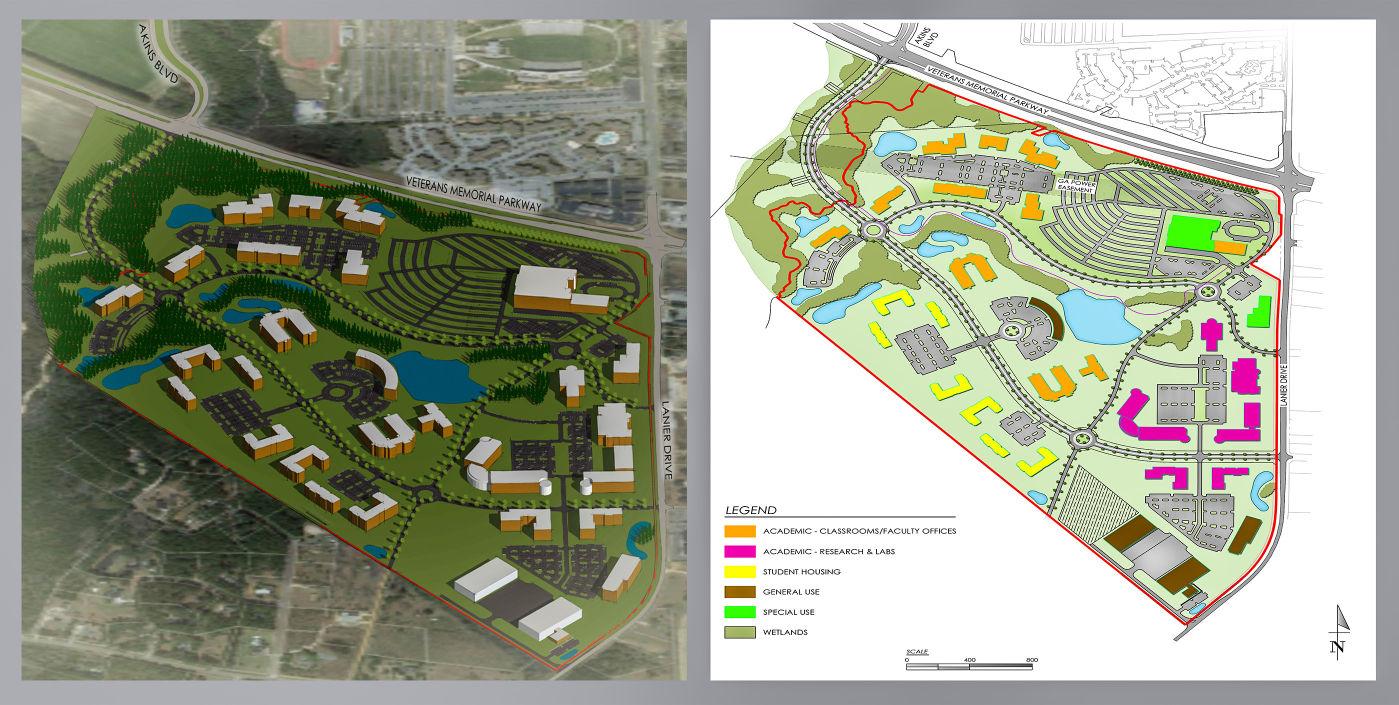South Campus Conceptual Master Plan shows projection for future expansion
April 12, 2016
On the 208 acres of undeveloped land owned by Georgia Southern University, located south of Veterans Memorial Parkway and west of Lanier Drive, the university is currently building a warehouse as part of the South Campus Conceptual Master Plan.
The South Campus Conceptual Master Plan is a document that represents potential development on the 208 acres of land. According to Robert Whitaker, GSU vice president for business and finance, the master plan, which includes several academic and housing facilities, serves to project needed development as the university grows in the future.
“We developed the master plan that you see out there on our website with basically just taking a stab at what we would need as we continue to grow for the next twenty years, thirty years, so you’re really looking far out in the future to try to develop what is just a conceptual design,” Whitaker said. “What you see out there may never happen. What you see will change.”
The warehouse, an $8 million project funded by the university’s internal funds, will serve as a storage unit for the university.
“The warehouse will hold procurement… There will be an archives-type repository which will be federally-approved at a certain level, so we can take some of our museum artifacts and put [them] out there… [they] will be in an enclosure that is more appropriate for those kinds of museum artifacts, and we’ll also just have a lot of general storage space,” Whitaker said.
Beyond the warehouse, there are no building plans for the land south of Veterans Memorial, according to Whitaker. Despite suggestions for a new dining facility and housing on the land, the master plan projects too far into the future to allow current planning.
“The dining facilities we have now are so new, and they are able to handle the volume that we are [seeing] right now,” Greg Crawford, director of residential dining, said. “So, there is really not much planned for the South Campus, that I know of, to open a dining facility, but I know we are still learning about the dining facilities and we have some changes that are to come soon.”
Because the land is relatively far from the rest of campus, students will need to be provided transportation from the main campus to the south campus.
“We would have to look to expand our bus transportation system, and we’ve talked about that… There’s a little bit of land strip there that would allow us to sync up with the road directly across from Aikens Boulevard, and we’re about ready to hopefully make that negotiation with the [landowners],” Whitaker said. “If we can make that happen, then we will take Aikens Boulevard and extend it straight on over in there… We would just take our bus route and have it circle around whatever buildings we have out there and come back through the main part of campus.”
Notably, the master plan includes the preservation of wetlands. According to Whitaker, the Environmental Protection Division (EPD) requires the conservation of wetlands.
“Our plan works around all those wetlands and allows us to do some small mediation to continue to allow those [wetlands] to exist,” Whitaker said. “[Wetlands are] a good example of why we do a Master Plan. We look at the different types of topography. We look at that and say, ‘Okay, we can’t really place buildings there on top of a wetland, so how do we put things around that so we can protect that?’”
Nicholas Radko, geology lecturer, says that buildings in wetlands are often at greater risk of flooding, and buildings situated on drained wetlands slowly sink into the ground. He also notes the importance of preserving wetlands.
“Preserving wetlands is critical,” Radko said in an email. “Wetlands accommodate runoff and floodwaters during storm events. When you put up a ton of buildings and parking lots, [which are] impermeable surfaces, runoff increases, making it even more important to have wetlands. Wetlands will also biologically filter the water. Contaminants in runoff can settle out or be broken down [or] absorbed by organisms, which often makes the water leaving cleaner than it started out. Finally, they encourage biodiversity.”
Photo courtesy of http://bf.georgiasouthern.edu/facilities/south-campus-conceptual-master-plan/



